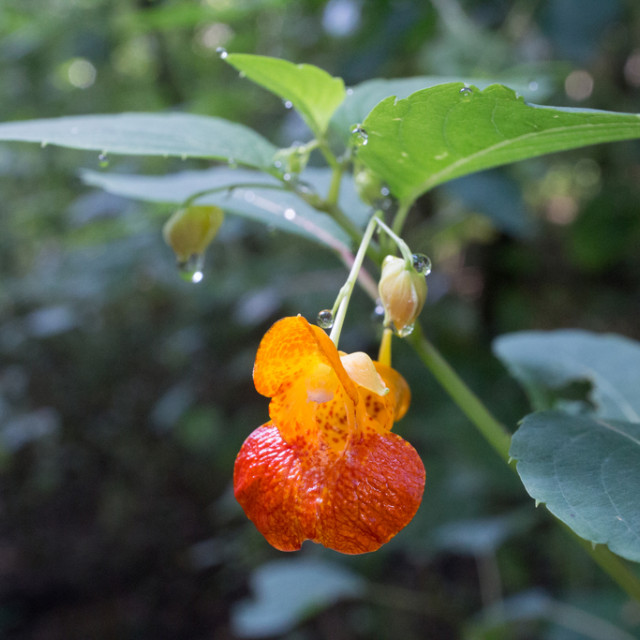COMMON NAME
Jewelweed
SCIENTIFIC NAME
Impatiens capensis
ALSO KNOWN AS
Touch-me-not
Plant family
Touch-me-not (Balsaminaceae)
Plant group
Wildflowers and Herbs
A succulent upright herb growing 2-5 feet tall, usually in dense stands. The stems are hairless and somewhat translucent.
90 reports
27+
OBSERVERS
90+
OBSERVATIONS
Identification hints
When the leaves of Jewelweed are put underwater, their leaves appear silvery. Pale jewelweed, Impatiens pallida has a very similar appearance and can be found growing in similar habitats to the orange Jewelweed, however the flowers of Pale jewelweed are yellow.
Did you know?
Jewelweed is adapted for hummingbird pollination, but is also visited by bees and butterflies. It's believed that jewelweed can relieve poison ivy rashes.
DISTRIBUTION IN TH U.S.
Alabama
,
Arkansas
,
Colorado
,
Connecticut
,
District of Columbia
,
Delaware
,
Florida
,
Georgia
,
Iowa
,
Idaho
,
Illinois
,
Indiana
,
Kansas
,
Kentucky
,
Louisiana
,
Massachusetts
,
Maryland
,
Maine
,
Michigan
,
Minnesota
,
Missouri
,
Mississippi
,
North Carolina
,
North Dakota
,
Nebraska
,
New Hampshire
,
New Jersey
,
New York
,
Ohio
,
Oklahoma
,
Oregon
,
Pennsylvania
,
Rhode Island
,
South Carolina
,
South Dakota
,
Tennessee
,
Texas
,
Virginia
,
Vermont
,
Washington
,
Wisconsin
,
West Virginia
HABITAT
Jewelweed is a common plant in most parts of its range, especially in moist soil like floodplains, seeps, and roadside ditches, also on edges of woodland paths. It can be found both in disturbed habitat and more high quality habitat.
ATTRIBUTES
Leaves
Jewelweed has oval, thin-textured leaves that are light green in color, usually measuring up to 2½" long and 1½" across, but sometimes up to twice this. The leaf margin has low, broad teeth, and the leaf stalk (petiole) is slender, up to 2" long.
Flowers
Flowers are found on dropping flower stalks (petioles) in loose groups of 1 to 3. Flowers are conical shaped, orange with red streaks and spots, with upper and lower lips. The flower has three sepals, two of which are small and light green and appear sepal-like. The lower sepal is the conical part of the flower, which is orange and red, like the petals. At the tip of the third sepal is a nectar spur.
Fruits
The fruit of jewelweed is an oblong capsule. When ripe, the capsule explodes, flinging the seeds away. Even a slight touch can cause the capsule to explode, thus one of the common names, "touch-me-not."
Bloom Time
Jewelweed blooms mid summer to early fall, the flowering period lasting about two months.
See Menu
Budburst is a project of the
Chicago Botanic Garden
One of the treasures of the
Forest Preserves of Cook County
Creative Commons
BY-NC-SA 4.0
- 2021 Chicago Botanic Garden. All Rights Reserved.
- Terms of Use
- Privacy Policy
- Data Sharing and Citation Policies
- 2021 Chicago Botanic Garden. All Rights Reserved.



